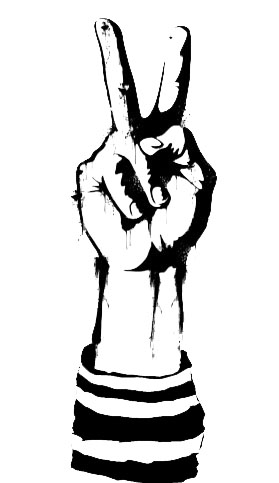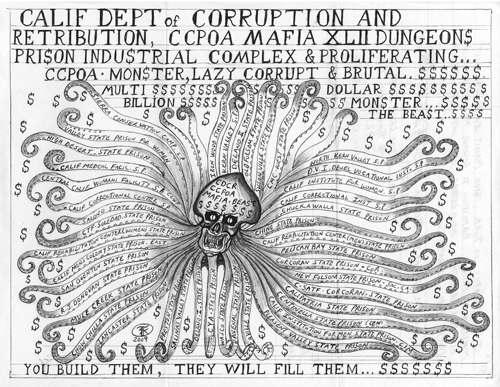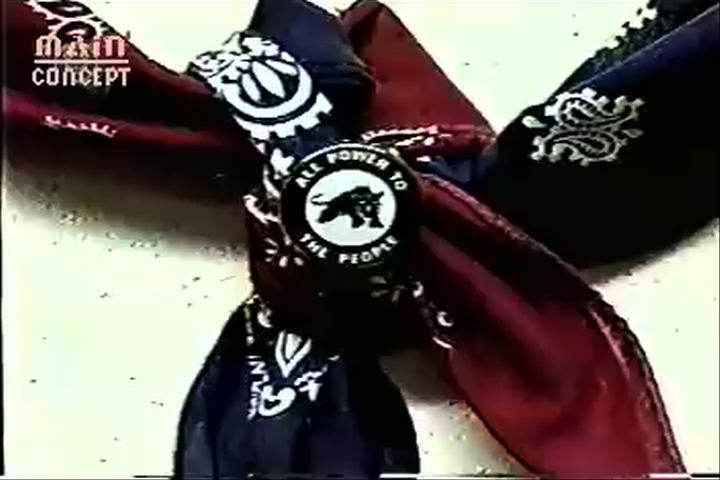The main purpose of issue 7 of Under Lock & Key is to show
who wants peace and who does not. We will also focus on our long-held
line that prisoners accomplish nothing by lashing out and fighting each
other or prison staff. Every prison that censors this newsletter is
acknowledging that peace among prisoners is contrary to their goal of
so-called “security,” further substantiating our thesis presented below.
Time has proved . . . that blind deference to correctional officials
does no real service to them. Judicial concern with procedural
regularity has a direct bearing upon the maintenance of institutional
order; the orderly care with which decisions are made by the prison
authority is intimately related to the level of respect with which
prisoners regard that authority.
There is nothing more corrosive to the fabric of a public institution
such as a prison than a feeling among those whom it contains that they
are being treated unfairly.” Palmigiano v. Baxter, 487 F.2d 1280, 1283
(CA1 1973). As THE CHIEF JUSTICE noted in Morrissey v. Brewer, 408 U.S.
at 408 U. S. 484, “fair treatment . . . will enhance the chance of
rehabilitation by avoiding reactions to arbitrariness.
-dissenting
opinion from Wolff v. McDonnell, 418 U.S. 539 (1974)
Our track record speaks for itself. At least dozens of prisoners and
former prisoners have given up lives that once included physical attacks
on cops, and often fights with other people as well, after taking up the
anti-imperialist struggle through MIM. Unfortunately, our data is a
little skewed since we can only speak for prisoners who we are in
contact with. It is up to an ambitious researcher to demonstrate
statistically that those involved in anti-imperialism are less violent
than those who aren’t (or more so as the prison mail rooms across the
country claim is the case).
In the meantime, there are plenty of studies showing how all sorts of
educational and family programs help reduce violence and anti-social
behavior. (1) Unfortunately, in a system focused on punishment and
ostracizing groups of people, these programs are used to manipulate
rather than rehabilitate. U$ prisons that do offer these programs do so
in an effort to tempt prisoners with a carrot. By taking this
individualist approach they are not actually investing in peace or
progress. When priorities change and a prisoner loses his job or can no
longer see his loved one, then there is no longer the incentive to be
peaceful. In contrast, a dedication to the struggle for a world without
oppression cannot be taken away by future prison administrators.
Facts:
-
In decades of work the Maoist Internationalist Movement has never broken
bourgeois laws. In years of work, neither has MIM(Prisons).
-
Members of MIM and members of MIM(Prisons) have always been forbidden
from breaking the law.
-
MIM literature has never promoted breaking the law or taking up arms
against the united states government, or any local government or
organization, for that matter.
-
Every issue of Under Lock & Key, the newsletter of MIM(Prisons),
encourages prisoners to obey the laws and to avoid physical conflicts.
-
Anecdotal experience provides evidence of a pattern of reduced violence
among prisoners who become involved in MIM-led educational programs
and/or organizational campaigns.
Despite the facts listed above, our programs and materials are routinely
denied to prisoners all across the united $tates. In late 2007, we
launched our website where we have since recorded 509 incidents of
censorship. Most of those are censoring MIM(Prisons). Of them, 11 cite
“STG” or “Security Threat Group”, 34 cite “security” in general, 14 cite
a threat of “violence,” and 26 cite our threat to the “law” as the
reason they are censored. In addition, 164 took place in California,
where all MIM mail was banned because it allegedly “advocates seizing
public power through armed struggle and overturning prison
administrations ‘by stripping them of control.’” (2) While the recent
legal struggles of one comrade in California brought to light a document
overturning this ban, it continues to be applied in many of the prisons
where MIM(Prisons) used to have a large readership. Most of the rest of
the incidents of censorship fall into the various categories of
“unacceptable”, “disallowed”, “unauthorized”, “refused” or there was
just no reason given whatsoever.
Security Threat Group (STG) is the buzz word developed in the 1990’s to
apply to a range of street and political organizations. Many so-called
“correctional professionals” claim MIM(Prisons) is an STG. But exactly
what are we a threat to the security of? Copying the language of
precedent setting case law, it is often phrased as being “detrimental to
the security, good order, or discipline of the institution or […] it
might facilitate criminal activity.”) The problem with the phrasing in
this court decision is that many prisons interpret that to mean that if
you tell prisoners to file complaints, write the press, join
organizations or build lawsuits in response to torture, physical abuse,
lack of medical care, censorship, etc. then you are threatening the
“good order or discipline of the institution.” (THORNBURGH v. ABBOTT,
490 U.S. 401 (1989)
Reviews of this and other case law demonstrate that under capitalism in
amerika, prisoners actually do have rights and the above interpretation
is a violation of them. The real meaning of this law should be to allow
prison administrators to censor materials that promote real and
immediate threats to safety and security, such as plans to attack
someone else in the prison or to smuggle in weapons. The most recent
case condemning prisoncrats for preventing prisoners from receiving
materials that promote legal resistance was just last year when a
comrade in Wisconsin won his suit in federal court. (3)
In some cases the prison administration has interpreted the law the same
way we do, but still claims we violate it by posing an immediate threat
to safety and security. The California ban letter cited above is one
example of this. In these cases we also disagree to the point of getting
the bourgeois courts involved.
The October 2006 memo from CDCR Director Scott Kernan banning MIM
publications (supposedly not all our mail) has completely inaccurate
statements in it, such as the one quoted above. If it were possible to
demonstrate that MIM promoted violence in prisons or breaking the law
without lying, one of the state lawyers would have done it by now. Their
favorite defense in many states is to hide behind prison walls, rather
than lie like Scott Kernan did. That is why state officials need to be
publicly accountable in any society claiming democracy in any form.
From the CO’s up to the director, they play the text book role of the
bureaucrat attempting to defend their corrupt institution, and by proxy
their own lucrative jobs. We admit to being a threat to the jobs of
corrupt officials and abusive institutions, as any conscious and active
citizen should be.
In this issue you’ll read stories of foiled peace plans, violent set-ups
and hazard pay for CO’s. The various unions representing so-called peace
officers are some of the strongest in the country and their main
leverage tool is persynal safety. They say, “we’re putting our lives at
stake to protect your shit, you better pay us good.” Hence the built in
motivation for more violence, more riots, more “validated” gang members
and more maximum security and supermax prisons. It all means more money
in their pockets.
More generally, amerikans as a whole benefit from their positions of
power over the oppressed. Middle class amerikan citizens benefit from
being members of the group of people who can be cops or get similar jobs
as oppressors in the criminal injustice system, and they benefit from
the services the cops provide in maintaining lines between social
groups. So it is not just an individualist motivation for higher pay, it
is also a national consciousness that is necessary to create the us
vs. them mentality necessary to run prisons the way they do in the
united $tates. One example of this consciousness came up during the
Giuliani reign of terror in New York City in the 1990s, when the New
York Times reported that most white residents were comfortable with the
police behavior they saw, while nine out of ten Blacks felt that “the
police often engaged in brutality against blacks.” (4)
These national lines of us vs. them were created by the white settlers
and is deep in that history of land grab and slave trading. Over time
this forces the oppressed to see the world in a similarly divided way,
leaving the oppressors with two choices: they can turn around and use it
as a justification for their own brutality, or they can de-escalate the
contradiction. Our analysis of imperialism and the principal
contradiction predicts that amerikans cannot de-escalate the
contradiction, and so far we’ve been proven right. And that is why u$
prisons have become a perversely violent microcosm of amerikan society.
While we believe that in general cops and CO’s have a vested interest in
opposing our efforts to promote peace, we are also acting in United
Front with those employed by the vast u$ criminal justice system who are
more interested in making it home to their family each night than
getting hazard pay and new high tech toys to play with. This is unlikely
in places like California where history has already demonstrated what
happens to prison staff who speak against these interests. On a related
note, MIM(Prisons) does not threaten people’s lives, berate people into
suicide, or carry out assassinations.
Many prison staff claim MIM(Prisons) is a threat because we encourage
prisoners to organize. We look to history again, and help quell those
fears by taking a look at two of the greatest examples of prisoners
organizing themselves. In the Attica rebellion in 1971, no CO’s were
killed until the National Guard came in and shot 11 employees dead,
along with 29 prisoners. Up until that point the prisoners of Attica had
organized a democratically run society within the prison walls,
including such things as their own food and medical services, while
negotiating with the state on behalf of all prisoners. Guards were given
superior treatment the whole time.
A couple years later prisoners in Walpole were left to run the prison on
their own when the guard union went on strike. They set up similar
services as the prisoners in Attica, and actually increased the
efficiency of the operating of the prison with the guards and
bureaucrats out of the way. This shows that as early as the early 1970’s
prison guards were paid high wages for doing nothing. Since then the
prison population has increased 8-fold, fattening the labor aristocracy
with high paying jobs along the way.
The prisoners peacefully functioning without overseers shocked the pigs,
who then began to spread rumors about riots in Walpole. The riots never
happened, and in fact there was an end to all violence and rape during
the weeks while the prison guards were absent, and for some time to
follow. This kind of rumor mongering is not unique to a particular group
of mean-spirited CO’s. Rather, they were representing the inherit
self-interest of this class of people. In the last 15 to 20 years in
California, they have succeeded in creating a constant atmosphere of
disturbance and violence. Only the minority see their self-interest in
peace, because it is a threat to their jobs as a class.
Unfortunately, we can expect much violence from the oppressors before we
can expect an honest assessment of what is going on in these secretive
dungeons. The people want peace now. Communities that are being
occupied, imprisoned and bombed want an immediate end to violence.
Huey P. Newton said it is up to the oppressor whether meeting such
demands of the oppressed happens in a peaceful way or a violent way.
Fanon said violence is part of the development of a humynism and new
consciousness among the people. Even if Fanon is right, it takes a lot
to push the masses to the point of violence as Huey pointed out. This is
obvious by the many more people who have spent many more days in
peaceful submission than those who have not. Violent resistance from the
people will only arise as it is necessitated by those who monopolize
violence through their own power.
MIM(Prisons) only engages in and promotes legal means of combating
injustice. When the prison staff represses every educational and legal
outlet for prisoners to redress their complaints then it is clear what
kind of strategies they are promoting. In those prisons, we predict
there will be violence, and they cannot blame it on us because they have
kept us out. This is similar to what we say about all struggles for
justice around the world. We believe violence is necessary to end
injustice because history has demonstrated that the oppressor never
stops oppressing any other way. We do not want or promote violence, we
are merely stating our conclusion from reading history. In every case of
revolutionary war, it was up to the oppressor to decide whether violence
was used or not. History shows that the same has been true in the prison
rights movement; the struggle for prisoner rights has
only become violent when the state initiated such
violence.
Notes:
- “Since 1990, the literature has shown that prisoners who attend
educational programs while they are incarcerated are less likely to
return to prison following their release. Studies in several states have
indicated that recidivism rates have declined where inmates have
received an appropriate education. Furthermore, the right kind of
educational program leads to less violence by inmates involved in the
programs and a more positive prison environment.” Journal of
Correctional Education, v55 n4, p297-305, December 2004.
See also The Nation, March 4, 2005: “Studies have clearly shown that
participants in prison education, vocation and work programs have
recidivism rates 20-60 percent lower than those of nonparticipants.
Another recent major study of prisoners found that participants in
education programs were 29 percent less likely to end up back in prison,
and that participants earned higher wages upon release.”
- the full text of this letter is available on our website along with
tons of other documents related to the California ban:
https://www.prisoncensorship.info/campaigns/ca/
(if you’re a California prisoner you’ve probably already seen it)
- Lorenzo Johnson v. Rick Raemisch, Daniel Westfield, and Michael
Thurmer, Case No. 07-C-390-C US District Court Western District of
Wisconsin
available soon on our archive page
- Hayden, Tom. Street Wars. The New Press, 2005. p. 108.

 As
I write this letter I am once again incarcerated in the administrative
segregation dungeon (ad-seg) of Mule Creek State Prison for refusing to
conform to the CDCR-CCPOA Mafia underground corruption rules of forced
double celling.
As
I write this letter I am once again incarcerated in the administrative
segregation dungeon (ad-seg) of Mule Creek State Prison for refusing to
conform to the CDCR-CCPOA Mafia underground corruption rules of forced
double celling.





 Alabama
Alabama
 Alaska
Alaska
 Arizona
Arizona
 Arkansas
Arkansas
 Army Post
Army Post
 California
California
 Colorado
Colorado
 Connecticut
Connecticut
 Delaware
Delaware
 District of Columbia
District of Columbia
 Federal
Federal
 Florida
Florida
 Georgia
Georgia
 Guam
Guam
 Hawaii
Hawaii
 Idaho
Idaho
 Illinois
Illinois
 Indiana
Indiana
 Iowa
Iowa
 Kansas
Kansas
 Kentucky
Kentucky
 Louisiana
Louisiana
 Maine
Maine
 Maryland
Maryland
 Massachusetts
Massachusetts
 Michigan
Michigan
 Minnesota
Minnesota
 Mississippi
Mississippi
 Missouri
Missouri
 Montana
Montana
 Nebraska
Nebraska
 Nevada
Nevada
 New Hampshire
New Hampshire
 New Jersey
New Jersey
 New Mexico
New Mexico
 New York
New York
 North Carolina
North Carolina
 North Dakota
North Dakota
 Ohio
Ohio
 Oklahoma
Oklahoma
 Oregon
Oregon
 Pennsylvania
Pennsylvania
 Puerto Rico
Puerto Rico
 Rhode Island
Rhode Island
 South Carolina
South Carolina
 South Dakota
South Dakota
 Tennessee
Tennessee
 Texas
Texas
 Utah
Utah
 Vermont
Vermont
 Virginia
Virginia
 Washington
Washington
 West Virginia
West Virginia
 Wisconsin
Wisconsin
 Wyoming
Wyoming

 For
our Peace Issue, MIM(Prisons) had solicited a number of allies who are
doing work for peace among the lumpen on the streets. Though the Peace
Issue is done, our pages remain open to those who are doing such work,
as we want to build as many connections as we can between what is going
on in the streets and behind prison walls. This article will make some
of those connections in a mostly historical way. Similar stories can be
told about the largest street organizations based in Los Angeles, New
York, Chicago and beyond. And as we’ll see, the use of prisons to
isolate the peace makers is having a very real impact on efforts in
oppressed communities.
For
our Peace Issue, MIM(Prisons) had solicited a number of allies who are
doing work for peace among the lumpen on the streets. Though the Peace
Issue is done, our pages remain open to those who are doing such work,
as we want to build as many connections as we can between what is going
on in the streets and behind prison walls. This article will make some
of those connections in a mostly historical way. Similar stories can be
told about the largest street organizations based in Los Angeles, New
York, Chicago and beyond. And as we’ll see, the use of prisons to
isolate the peace makers is having a very real impact on efforts in
oppressed communities.
